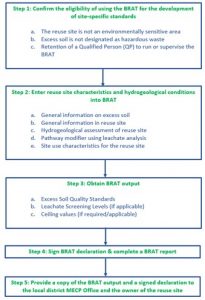Digging for Answers in Ontario’s Excess Soil Regulation and Beneficial Reuse Assessment Tool (BRAT)
Excess soil and the benefits of excess soil reuse
Excess soil refers to soil that has been excavated from a site (typically during construction or redevelopment activities), which can no longer be used at the development site. Local reuse of excess soil can have many financial and environmental benefits associated with marked reductions in transportation and landfilling activities; however, care must be taken to ensure that excess soil reuse occurs in a safe and effective manner.
Regulatory overview
To support the proper management of excess soils, the Ministry of Environment, Conservation and Parks (MECP) released Ontario Regulation 406/19 On-Site and Excess Soil Management (“the regulation”) under the Environmental Protection Act. The regulation provides guidance and rules on managing and reusing excess soil to facilitate local beneficial reuse, while ensuring the protection of human health and the environment.
The regulation took effect in December of 2019, and is being phased in three stages as follows:
January 1, 2021: Reuse rules, including risk-based standards, waste designation and approvals
January 1, 2022: Testing, tracking and registration (some exemptions apply)
January 1, 2025: Restrictions on landfilling soils
Regulatory requirements
As of January 1, 2022, the regulation includes excess soil reuse planning requirements that must be met before excess soil can be removed from a project area. These include:
- Completion of an assessment of past uses, a sampling and analysis plan, a soil characterization report and excess soil destination assessment report. These requirements must be completed prior to filing a notice on the Excess Soil Registry (Registry);
- Registration of a notice in the Registry, developed and implemented by the Resource Productivity and Recovery Authority (RPRA); and,
- Application of a tracking system.
It is noted that the regulation does provide several exemptions from some or all of the excess soil planning requirements noted above. General exemptions are described in Schedule 2 of the regulation, and exemptions for some reporting requirements are described in section 14 of the regulation. It is recommended that project leaders and/or Qualified Persons (QPs) review the exemptions to determine whether their site meets the requirements.
The excess soil quality standards and role of the qualified person
As part of the excess soil reuse planning requirements, the regulation references risk-based excess soil quality standards (SQS) that excess soils must meet to ensure the protection of human health and the environment at the reuse site. The excess SQS were developed using a similar approach as the Site Condition Standards developed under the Records of Site Condition Regulation (O. Reg. 153/04) but with modifications to address soil volume, and groundwater and vapour intrusion protection. In addition, leachate screening levels have been developed for some contaminants (e.g., metals and some organic compounds) to be protective of several groundwater exposure pathways. The excess SQS and leachate screening levels are presented in the MECP’s Rules for Soil Management and Excess Soil Quality Standards. This document also summarizes important rules for excess soils, reuse sites and use of the excess SQS.
Under the regulation, a qualified person (“QP”), as defined in the Records of Site Condition regulation (O. Reg. 153/04), must be retained to assess the quality and potential reuse of excess soils from a project site. As a result, the QP plays an important role in the excess soil reuse process.
What happens if excess soils do not meet the generic excess soil quality standards?
In many cases, excess soil will contain elevated concentrations of contaminants which exceed the generic excess SQS. Fortunately, the MECP allows for the use of several strategies that can be employed to provide flexibility in meeting the applicable standards. Examples are provided below.
Use of background concentrations – if a QP can demonstrate that excess soil contains a chemical parameter that is naturally occurring at the reuse site and does not exceed the naturally occurring range of concentrations typically found in soil at the reuse site, then the chemical parameter can be deemed to meet the excess SQS if appropriate supporting documentation can be provided.
Statistical methods – in cases where twenty or more discrete soil samples have been collected within an area of potential environmental concern (APEC) or related area, statistical methods can be utilized to meet the excess SQS. Chemical parameters could meet the excess SQS if:
- A statistical metric representative of anticipated exposure (i.e., 90th percentile concentration or 95% upper confidence limit of the mean (UCLM) concentration) is below the excess SQS.
- No single soil sample exceeds the corresponding “ceiling value” for the chemical parameter(s) of interest. Ceiling values represent slightly higher generic excess SQS that can be used when a large sample size is collected from an APEC.
Generation of site-specific standards – if chemical a parameter(s) does not meet the generic excess SQS using the above methods, site-specific standards can be derived by a QP using the Beneficial Reuse Assessment Tool (BRAT). The development of site-specific standards aims to promote greater reuse of excess soil through consideration of local conditions, while protecting human health and the environment.
What is the BRAT and when can a QP apply site-use characteristics provided in the BRAT?
The BRAT is a spreadsheet model developed by the MECP which allows a QP to generate site-specific standards for a reuse site using a streamlined approach. The BRAT allows the QP to modify general reuse site characteristics and hydrogeological conditions in a site-specific manner and allows for the modification of certain exposure pathways by using pre-defined “site use characteristics” (e.g., shallow soil cap, fill cap or hard cap, building with a storage garage, etc.). Site-use characteristics can be utilized in the BRAT under two scenarios:
- Where a site-specific instrument (e.g., permit, license, approval), as defined by the regulation, is obtained which authorizes the use of the site use characteristic(s), including reference in the instrument to the site-specific excess soil standards developed from the BRAT; and,
- Where the selected site use characteristic(s) is part of the existing or planned site use (i.e., part of an undertaking related to “infrastructure” within the meaning of the regulation), rather than as a mechanism to manage potential risks associated with excess soil. For example, if an approved plan already includes the creation of a paved parking lot, then a hard cap barrier option could be utilized in the BRAT model.
When is the BRAT not applicable?
The BRAT cannot be used for a reuse site that is considered to be an Environmentally Sensitive Area (i.e., Table 1 Site) as defined by the Records of Site Condition Regulation (O. Reg. 153/04), or in cases where excess soil is designated as hazardous waste as defined in Ontario Regulation 347 (General-Waste Management). Additional limitations of the BRAT model can be found in A Guide for Developing Site Specific Excess Soil Quality Standards Using the Beneficial Reuse Assessment Tool (BRAT).
General Overview of the BRAT 
What can a project leader do when the BRAT does not apply or does not support the reuse of excess soils?
The derivation of site-specific soil standards using the BRAT may not always support the use of all excess soils. Under these circumstances, the project leader has a few options:
- The BRAT can be used to support the reuse of some excess soils generated at a development site. The remaining excess soils that do not meet the site-specific standards can be brought to a landfill;
- A risk assessment can be completed to support excess soil reuse. Risk assessments allow for greater flexibility in meeting the appropriate criteria through the use of additional site inputs and risk-based models; and,
- The project leader can find another reuse site where the generic or site-specific standards can be met.
For more information on how Intrinsik can help your company, please contact .
Intrinsik Bloggers:
Nicholas Maya, M.Sc.
Dr. Glenn Ferguson

